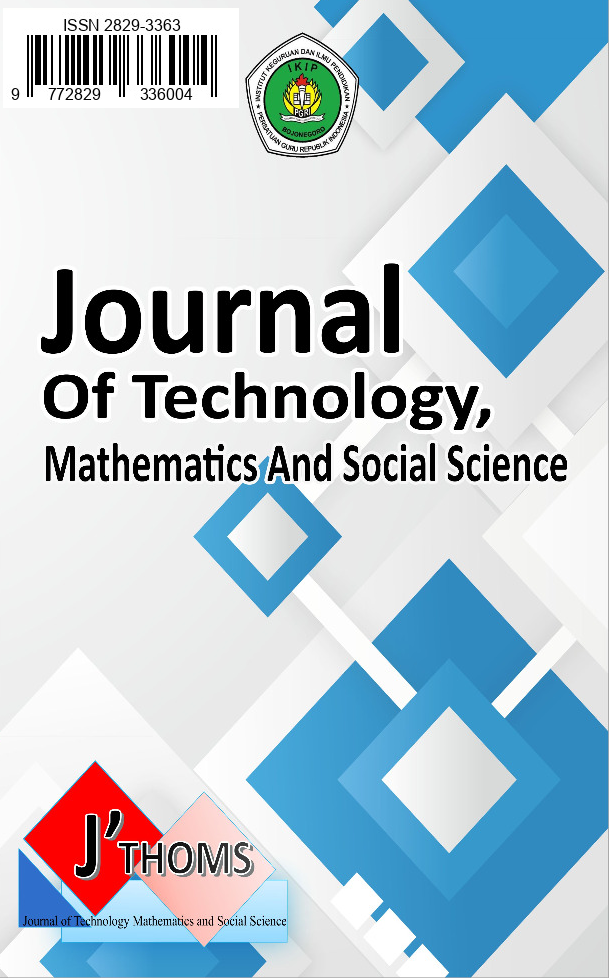ANALISIS PEMAHAMAN MATEMATIS SISWA SMPN 3 BOJONEGORO PADA MATERI PELUANG BERDASARKAN TEORI APOS
DOI:
https://doi.org/10.30734/j'thoms.v2i2.2960Abstract
The research was carried out by researchers with the aim of analyzing the mathematical understanding of the students of SMPN 3 Bojonegoro on the probability material based on the APOS theory. This research method is qualitative by using a qualitative descriptive approach with the researcher acting as the key instrument or main instrument. Based on the results of the analysis of mathematical understanding of students at SMPN 3 Bojonegoro based on APOS Theory. In the framework of the action stage, the subject has a tendency to explain and present the given opportunities. Subjects in the process stage framework have a tendency to explain, present and classify questions about probability events. Subjects in the process stage framework are subjects who have a tendency to explain, present, classify and apply concepts and procedures. In the framework of the last stage, namely the framework of the schema stage, the subject has a tendency to explain, present, classify, apply and develop the concepts that have been studied.
Keywords: Understanding Analysi; Mathematical Understanding; APOS Theory; Opportunity Material.
References
Abdullah, A. H., Abidin, N. L. Z., & Ali, M. (2015). Analysis of students’ errors in solving Higher Order Thinking Skills (HOTS) problems for the topic of fraction. Asian Social Science, 11(21), 133–142. https://doi.org/10.5539/ass.v11n21p 133.
Dubinsky, E., & McDonald, M. A. (2001). APOS: A constructivist theory of learning in undergraduate mathematics education research. In The teaching and learning of mathematics at university level (pp. 275-282). Springer, Dordrecht.
Fatimatuz Zahroh. (2021). Deskripsi Pemahaman Siswa Berdasarkan Teori APOS pada Pokok Bahasan Suhu dan Kalor. Dari Jurnal Natural Science Educational Research.
Jha, S. K. (2012). Mathematics Performance of Primary School Students in Assam (India): An Analysis Using Newman Procedure. International Journal of Computer Applications in Engineering Sciences. 2(1). Dari https://citeseerx.ist.psu.edu/viewdoc/download?doi=10.1.1.303.2464& rep=rep1&type=pdf.
Kusumawardani, D. R., Wardono, & Kartono. (2018). Pentingnya Penalaran Matematika dalam Meningkatkan Kemampuan Literasi Matematika. Dari . Prosiding Seminar Nasional matematika, 588-595
Sughesti, M. M., Muhsetyo, G., Susanto, H. (2020). Analisis Kesalahan Siswa Pecahan dan Penyebabnya. 4(2). Dari http://journal2.um.ac.id/index.php/jkpm/article/view/16715.
Sukestiyarno. (2020). Metode Penelitian Pendidikan. Semarang: UNNES Press.
Yuni, Y, Darhim, D, & Turmudi, T. (2018). Peningkatan Berpikir Intuisi dan Penalaran Matematis Melalui Pembelajaran Inquiry Berbasis OpenEnded. Prima: Jurnal Pendidikan Matematika, 2(2), 107—126. https://dx.doi.org/10.31000/prima.v2i2.7 60.
Widodo, H. (2015). Potret Pendidikan Di Indonesia dan Kesiapannya dalam Menghadapi Masyarakat Ekonomi Asia (MEA). 13(2). DOI: https://doi.org/10.21154/cendekia.v13i2.250
Wina Dwi, W. (2017). Analilis kemamuan pemahaman matematis siswa di SMP NEGERI 9 Cimahi pada materi himpunan. Dari Jurnal Penelitian Pendidikan.

